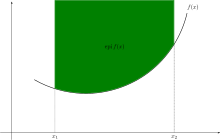Epigraph (mathematics)
In mathematics, the epigraph of a real-valued function 
If the image space of the function of 

Properties
Let be 


is convex if and only if the epigraph of
forms a convex set.
is semi-continuous from below if and only if the epigraph of
forms a closed set.
is weakly inferior if and only if the epigraph of
is a weakly sequence-terminated set.
- If
an affine-linear function, then its epigraph defines a half-space in
.
If the image space of the function of is 

The epigraph of a convex function is a convex set
See also
- Hypograph
Search within the encyclopedia
